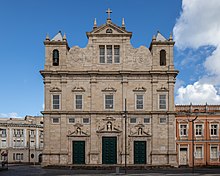
Back Centro histórico de Salvador de Bahía Spanish Salvador de Bahíaren hirigune historikoa Basque Centre historique de Salvador de Bahia French Centro Histórico de Salvador Portuguese Trung tâm lịch sử Salvador Vietnamese
| UNESCO World Heritage Site | |
|---|---|
 Largo do Pelourinho, Salvador | |
| Location | Salvador, Bahia, Brazil |
| Reference | 309 |
| Inscription | 1985 (9th Session) |
| Coordinates | 12°58′S 38°30′W / 12.967°S 38.500°W |







The Historic Center (US) or Centre (UK) (Portuguese: Centro Histórico) of Salvador de Bahia in Brazil, also known as the Pelourinho (Portuguese for "Pillory") or Pelo, is a historic neighborhood in western Salvador, Bahia.[1] It was the city's center during the Portuguese colonial period and was named for the whipping post in its central plaza where enslaved people from Africa were publicly beaten as punishment for alleged infractions. The Historic Center is extremely rich in historical monuments dating from the 17th through the 19th centuries.
Designated a UNESCO World Heritage Site, the Pelourinho retains a vibrant repertoire of colonial Portuguese architecture, exemplified by the Mannerist decoration of the Cathedral of Salvador, the Baroque intricacy of the Church and Convent of São Francisco and the Church of the Third Order of Our Lady of the Rosary of the Black People, as well as the Rococo exuberance of the Church of Nosso Senhor do Bonfim. In addition, the Pelourinho remains a cultural hub for the Afro-Brazilian community, whose cuisine, architecture, religion and music exert a salient influence on the neighborhood and testify to the "empowerment and influence of Afro cultures"[2] in the New World. Although historical preservation efforts initiated in the 1990s enhanced safety, promoted tourism and facilitated greater economic development, they also resulted in the dislocation of Afro-Brazilian residents in the enclave and contributed to gentrification. As such, the development of the Pelourinho continues to attract attention in the gubernatorial politics of Bahia.
- ^ Cite error: The named reference
unescowas invoked but never defined (see the help page). - ^ "Beyond Colombia". Beyond Colombia. Retrieved 2021-03-05.
